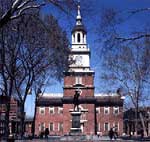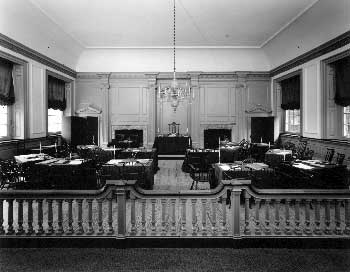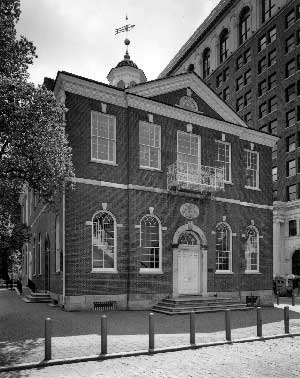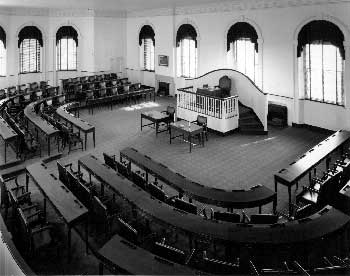






Survey of
Historic Sites and Buildings
 |
Independence National Historical Park Pennsylvania |
 Independence National Historical Park |
| ||
In this park, at Congress Hall, during the period that Philadelphia served as the Nation's Capital (1790-1800), occurred the inaugurations of George Washington, for his second Presidential term, and John Adams. Other structures in the complex also have associations with the Presidents. The park, in the old portion of the city, was also the scene of many major aspects of the Nation's founding and initial growth and several momentous national events. These include meetings of the First and Second Continental Congresses; adoption and signing of the Declaration of Independence, which marked the creation of the United States; and the labors of the Constitutional Convention of 1787, which perpetuated it.
The nucleus of the park and its outstanding historical building is Independence Hall. [For a detailed history and description of the hall as well as a discussion of historical events associated with it, see Founders and Frontiersmen, Signers of the Declaration, and Signers of the Constitution, Volumes VII, XVIII, and XIX respectively in this series.] Constructed as the State House for the Province of Pennsylvania between 1732 and 1756, it served as the principal meetingplace of the legislature until 1799, though in 1775-77 and in 1778-83 the Second Continental Congress convened there, as did also the Constitutional Convention in 1787. Serving in those bodies were future Presidents Washington, John Adams, Jefferson and Madison. The carefully restored, stately, and symmetrical hall, a 2-1/2-story red brick structure, is the most beautiful 18th-century public building of Georgian style surviving in the United States.
 |
| Restored Assembly Room, Independence Hall, one of the meeting places of the Second Continental Congress, where the Declaration of Independence and the Constitution were also debated, adopted, and signed. Future Presidents Washington, John Adams, Jefferson, Madison, and Monroe helped found the Nation in this room. (National Park Service, Robin Miller, 2001.) |
The interior focus of interest is the Assembly Room, the east one on the first floor, where the Declaration of Independence and the Constitution were formulated and signed. It has been restored to its appearance at the time of the Continental Congress, though only a few original items remain in the room.
When the Federal Government moved from New York City to Philadelphia in 1790, the city council offered for the use of Congress a recently constructed building on Independence Square, at the southeast corner of Sixth and Chestnut Streets just west of Independence Hall. Built between 1787 and 1789 as the County Court House (subsequently known as Congress Hall), it is a two-story brick structure with a projecting south bay and a peaked roof, topped by a cupola.
Congress convened there in December 1790, the Senate meeting in a small chamber on the second floor and the House of Representatives in a larger one on the first. Some Members of Congress during this period—Madison, Monroe, Jackson, and William Henry Harrison—were later Presidents; and Vice Presidents John Adams and Jefferson presided over the Senate at the time. In March 1793 in the Senate Chamber, George Washington recited the oath of office for his second term as Chief Executive. In a similar ceremony 4 years later in the House Chamber, John Adams succeeded him.
After 1800, the year the Federal Government relocated to Washington, the city of Philadelphia utilized Congress Hall. Except for the enlargement of its south facade in 1793, it has changed little throughout the years. The National Park Service has restored and refurnished the interior of the hall to approximate the appearance while it was the meetingplace of Congress.
For short periods in 1793 and 1794, during yellow-fever epidemics in Philadelphia, President Washington resided at the Deshler-Morris House, 5442 Germantown Avenue, in Germantown, part of the park though 7 miles away.
The site of one of two no-longer extant adjoining homes (1785-90 and 1790-95) once owned by Robert Morris, on the southeast corner of High (present Market) and Sixth Streets, is related to the Presidency. In the first of these, Washington stayed with Morris during the Constitutional Convention. During the period when Philadelphia was the U.S. Capital, Morris also made the house available as a temporary Presidential mansion, and Washington and John Adams occupied it.
In 1797 the city of Philadelphia completed an official Presidential mansion outside the boundaries of the present park, but it was never utilized for that purpose and has long since disappeared.
 |
| Congress Hall, exterior. (National Park Service, Robin Miller, 2001.) |
In connection with the U.S. Bicentennial commemoration, the National Park Service has reconstructed the Jacob Graff, Jr., House and City Tavern. Jefferson, a roomer, wrote the Declaration of Independence in the 3-1/2-story brick Graff House, 2 blocks from Independence Hall on the southwest corner of Seventh and Market Streets. The first floor contains displays; the parlor and bedroom that Jefferson lived in on the second floor have been restored and are furnished with period pieces. City Tavern, at the northwest corner of Walnut and Second Streets, where members of the Constitutional Convention and Continental Congress and Government officials, including some future Presidents, stayed while in Philadelphia, is furnished and operated as an 18th-century tavern.
The American Philosophical Society, founded in 1743 by Benjamin Franklin and the oldest learned society in the United States, maintains its headquarters in Philosophical Hall (1787). Its distinguished membership has included many Presidents.
Many other sites and buildings in 22-acre Independence National Historical Park, most of which are open to the public, are related to other themes of history than the Presidency. Properties that are owned by the city of Philadelphia but administered by the National Park Service consist of Independence Hall, Congress Hall, City Hall (1791), and Independence Square. In recent years, to enhance the setting of the area, the Commonwealth of Pennsylvania has created Independence Mall in the three blocks across Chestnut Street directly north of Independence Hall; the National Park Service administers it. The Liberty Bell, a worldwide emblem of freedom, is displayed in a special pavilion on the mall.
 |
| Congress Hall, interior. U. S. House of Representatives. (National Park Service, Robin Miller, 2001.) |
Federally owned buildings include the First Bank of the United States; the Second Bank of the United States (Old Custom House), which features the park's extensive collection of historical portraits;Deshler-Morris House, operated by the Germantown Historical Society; Todd House; Bishop White House; New Hall (Marine Corps Museum); Pemberton House (Army-Navy Museum); and the Philadelphia (Merchants') Exchange. Among those privately owned properties whose owners have cooperative agreements with the National Park Service are Carpenters' Hall and Christ Church, both National Historic Landmarks, and Gloria Dei (Old Swede's Church) and Mikveh Israel Cemetery National Historic Sites. The American Philosophical Society holds title to Philosophical Hall, another Landmark and the only privately owned building on Independence Square, but also operates Library Hall, on Federal land.
In 1948, upon recommendation of the Philadelphia National Shrines Park Commission, Congress created Independence National Historical Park. This act specified the Federal Government's role in the commemoration of existing historic sites and buildings and in the acquisition and management of others. The entire undertaking is guided by an advisory commission of distinguished citizens. Many individuals and private and civic organizations have contributed to the preservation and beautification of the park.
 |
 |
http://www.cr.nps.gov/history/online_books/presidents/site53.htm
Last Updated: 17-Mar-2004